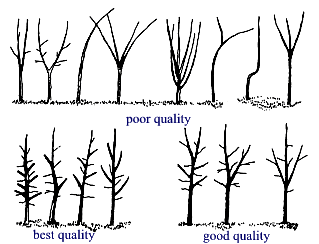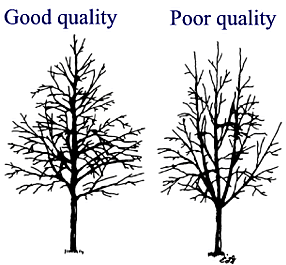Home > Nursery tree production > Specifications/standards > Florida grades and standards > Evaluating trunk and branch structure
Evaluating trunk and branch structure
 1)
Trunk structure: Shade trees that are large at maturity, and most
evergreen trees, with the best quality have a dominant or central leader
or trunk up to the top of the canopy. Shade trees of lesser quality have
two or more leaders or trunks; they could split apart as they grow older.
Small ornamental trees can have several trunks. (Note: Trees are drawn
without leaves or small diameter branches to show their trunk and branch
structure only. The end portions of large diameter branches are also cut
off to save space in the illustration. These drawings apply to evergreens
as well as deciduous trees).
1)
Trunk structure: Shade trees that are large at maturity, and most
evergreen trees, with the best quality have a dominant or central leader
or trunk up to the top of the canopy. Shade trees of lesser quality have
two or more leaders or trunks; they could split apart as they grow older.
Small ornamental trees can have several trunks. (Note: Trees are drawn
without leaves or small diameter branches to show their trunk and branch
structure only. The end portions of large diameter branches are also cut
off to save space in the illustration. These drawings apply to evergreens
as well as deciduous trees).
2) Branch structure: The better quality, large-maturing shade trees (lower extreme left) have all branches less than about two-thirds the trunk diameter. Poor quality shade trees (lower left center) have larger upright branches. Trees such as crapemyrtle and other small-maturing trees can have several trunks. Trees with extensive defects in branches such as cracks and included bark (lower right) represent lesser qualtity than trees free of these potential problems. Included bark can be seen between the two arrows below. Branches with bark inclusions are weakly attached to the tree and can split easily.



